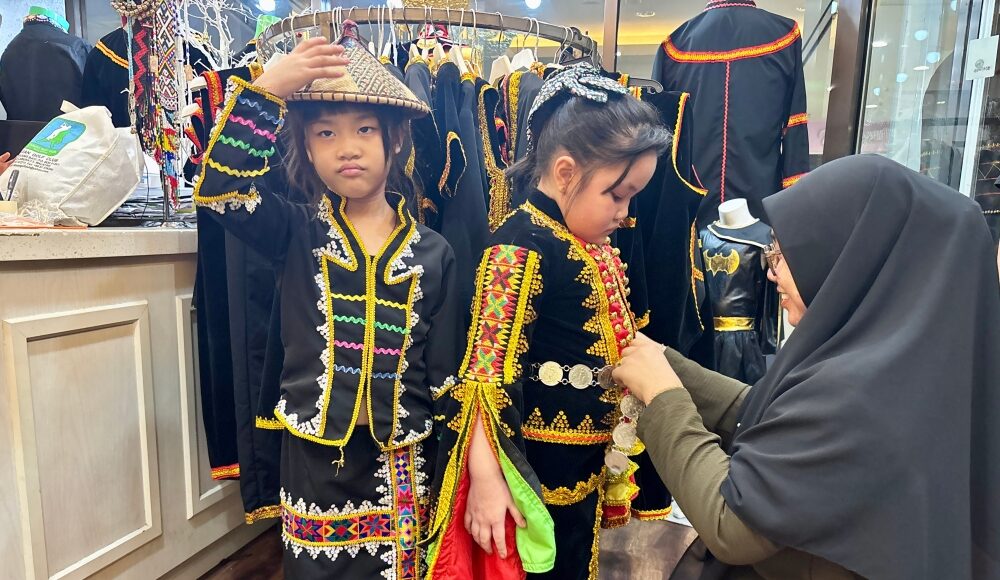KOTA KINABALU, May 31 — During the month-long Kaamatan fest, Sabahans are not only celebrating their cultural roots — they’re evidently wearing them with pride.
The distinct black-and-gold trimmed traditional costumes of the Dusun tribes, the colourful beading of the Rungus and the many Murut motifs are donned by Sabahans of all walks of life whether they’re at a social gathering, at the Kadazandusun Cultural Association (KDCA) or at school.
For seamstress Asurah Karim, Kaamatan is unarguably her busiest time of the year.
“Before May, we have to prepare to restock everything. The demand is 10 times higher than usual,” said the 41-year-old tailor, who has been making traditional costumes in her boutique in Penampang since 2018.
“We usually close shop at 7.30pm but this month, we have been working till past 10.00pm to finish sewing dresses, and that’s because the mall starts closing down and the security guards tell us to leave,” she said.
Tailors across the state are catering to the many Kaamatan events — from kindergarten dress-up to Sugandoi competitions, wedding parties and formal government functions.
Her most requested designs? “Dusun Tindal. Always the top,” she said, adding that Dusun Labuk of Beluran styles are also popular this year. Dusun Tindal also known as sinipak is from Kota Belud and has highly intricate details including layered sleeves.
The business spike is significant — income in May can be “up to 10 times” higher than in other months.
Kaamatan is an auspicious month for the Kadazandusun, Murut and Rungus communities to get married, adding to the demand for outfits.
From Penampang to Perth
Asurah, who was born in Kundasang to an ethnic Indian father and Bajau Laut mother, grew up helping her mother, a seamstress, with needlework.
Asurah Karim (right), known for her traditional costumes, with one of her many multiracial clients. — Picture by Julia Chan
“At 14 years old, I worked part-time at Love Tailor in Centre Point with my mother. That’s where I got exposed to all kinds of traditional attire,” she said.
Since starting her own business, Zay Boutique in 2018, Asurah has served hundreds of clients locally and abroad. Sabahans from the east coast district of Semporna to the interiors of Keningau and Tambunan would place their orders by phone or WhatsApp and drive to Penampang on the weekends to collect them.
“We’ve sent costumes to Australia too. They celebrate Kaamatan there too and people want to connect with their roots by wearing the costumes of their heritage,” she said.
Bernadita Marcellina Michael, the owner of Olumis769 — another traditional costume specialist — said her orders also extend beyond Sabah, and during the month of Kaamatan, she sees double her usual business.
“People from Sarawak, Johor, and even Melbourne have ordered from us. We cater to local councils, government agencies, universities, schools, and private companies… we also do rentals for those who prefer,” she said.
Her most popular costumes also include the Dusun Penampang traditional dress, the Sinipak from Kota Belud, Dusun Gana from Keningau and the Dusun Sonsogon costume from Kota Marudu.
“Costumes from other ethnic groups, such as the Murut and Lundayeh, are also in high demand,” said Bernadita.
What used to be a niche and expensive pursuit has now grown into a thriving cottage industry.
“Before the last 10 years, it was rare to find ready-made traditional clothes. They were expensive to make and not many people provided the service. Nowadays it’s more available and affordable,” she said.
A full costume made of velvet with trims used to start at RM800 to RM1,500. These days, a similar outfit — perhaps made with black cotton instead of velvet — can start at RM300. The more bells and whistles you add, the more it will cost.
“If the trims and beadings are handmade then the price will go back up. The brass bells and beads also cost a lot. The more it is customised, the longer it will take to complete, and the pricier it will get. But even so, it is far easier now than it was before,” she said.

Bernadita Marcellina Michael is the owner of Olumis769. — Picture courtesy of Olumis769
The increased accessibility and demand have also expanded her clientele to include children. Part of this is due to the growing appreciation and awareness for cultural preservation in schools and beyond.
“Kindergartens, primary schools, shopping centres… many are organising children’s Kaamatan pageants or competitions, and we don’t mind spending on her costumes,” said Lorna Anthony, whose own daughter, Ashley Bea Chris will be wearing a rented Dusun Tindal costume for her kindergarten’s Kaamatan festival this week.
Ashley’s classmate, Darcy Lynne, is wearing a Dusun Papar outfit rented from Zay Boutique.
“I have my own traditional dress. Several of them, from various districts so I can rotate every year. But for Darcy Lynne, we thought best we rent for now,” said Darcy’s mother, Teresah Kumilau.
Cross cultural demand
Asurah sees her own diverse family background reflected in her clients.
“It’s not just Kadazan or Dusun people ordering the Sabahan traditional dress now. We get Malays, Indians, mixed-race customers too. Everyone seems to want a piece of Sabahan culture,” said Asurah.
Bernadita said that about 30 per cent of her customers are from other races — Chinese, Malays, Indians. Kaamatan is truly for everyone,” she added.
But it’s not just traditional costumes that are in demand. Local designers are experiencing the same surge, Sabah influenced designs have grown in demand for occasions when a full traditional dress may be too much.
Seamstress Monguravung (@Normey Magarap), 55, owns a boutique in a Penampang mall that fuses traditional elements with contemporary silhouettes and does brisk business during the month of May.

Monguravung with her contemporary take on native-inspired outfits. — Picture by Julia Chan
“The peak season is May, followed by August for Merdeka Day and then December which is when a lot of weddings and festivities are happening. But May is definitely when there is most business,” said the Rungus native.
This year, she opened a month-long pop-up booth at the popular ITCC shopping mall in Penampang for more visibility.
She said that she started doing her modern take on traditional clothes as a complement to the many traditional costumes already available.
“Every piece I do is different. So, there’s only one like it. It’s only the traditional costume that has to remain the same,” she said.
However, Bernadita said that even when creating contemporary looks, it was important to ensure the correct ethnic motifs are used.
The demand for native inspired gowns and casual wear are particularly high during Kaamatan but she said people would wear them to gala nights for Unduk Ngadau and Sugandoi competitions.
For Sabahans, Kaamatan is more than a festival — it’s a cultural revival, and for these businesses, it is an honour to help ensure that tradition not only survives — but thrives.





